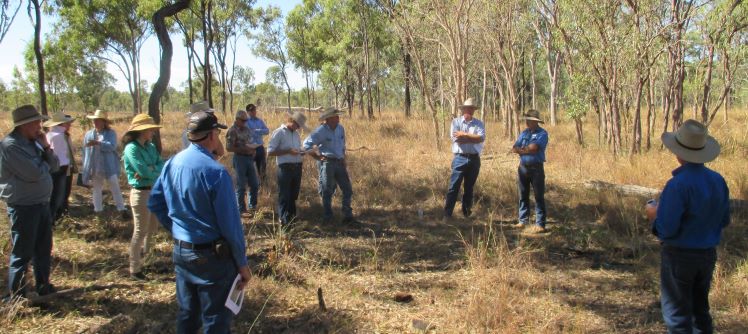Addressing land condition issues at Ametdale: part of the Northern Grazing Demonstration project
Background
Ian and Penny MacGibbon of Ametdale Station, St Lawrence, joined the Northern Grazing Demonstration Project to help address land condition and productivity issues. Ametdale is a breeding block with predominantly native pastures and moderately shallow soils on the flats. These soils are mostly hard-setting and subject to gullying, resulting in pasture management and cattle nutrition being key priorities for their business. The cattle are mostly high content Brahman adapted for the region. Nutritional deficits during the winter months are addressed with molasses and urea supplementation.
Ian and Penny monitor ground cover closely to ensure that most rainfall events result in good growth response in the perennial grasses. Strategic burning is undertaken in November to December if the season permits.

Grazing land management issues
While most of the property has good land condition, there are areas of bare soil and erosion on the flats in the ironbark country. Narrow-leaved ironbark is common with some Tea tree and Poplar gum. These degraded areas were probably instigated in the mid to late 1800’s when the area was first settled and were caused by poor grazing distribution and uneven utilisation. Waterpoint distribution was inadequate as it was restricted to the permanent holes in the creeks. Additionally, after the 1970’s when Townsville stylo was killed out by the Anthracnose fungus, native pastures with a lower carrying capacity were left. Patch grazing is a continuing challenge and has contributed to the change in pasture composition from a dominance of 3P (palatable, perennial and productive) pasture species to Indian couch.
Ian and Penny want to improve pasture condition and diet quality by increasing the proportion of the better grasses (3P%) in the pasture yield. To address these issues, Ian and Penny have focussed on two 1,200 hectare paddocks (Well and Top 9) with sub-division fencing to create five sub-paddocks allowing better control of grazing pressure and pasture spelling. The fencing also allows the Ironbark flats to be separated from the Ironbark ridges.
A consultative group of graziers addressing similar issues was established and the group was updated on the latest findings from the Wambiana grazing trial to apply the learnings to the case study paddocks.
Rainfall was well below average for 2017-18 and 2018-19. The 2019-20 summer generated a good pasture response and the start of an improvement in land condition.
Adaptive management and pasture monitoring
The sub-division fencing allows eight weeks rest and 20 days grazing over the wet season with usually two grazes from May to December and two from December to April. If there is an extended wet season then the number of grazes may be increased. In April 2018, cattle numbers were reduced in both paddocks to around half of the long term carrying capacity (LTCC), in line with the low wet season pasture growth (Table 1).
Cattle numbers in Top 9 paddock were kept low in 2019-20 and combined with better seasonal conditions resulted in high pasture yields, good ground cover and an improvement in the 3P%.
Well paddock had a higher starting 3P% and this was maintained. Cattle numbers will be kept at around 70% of LTCC across both paddocks until after the 2020-21 summer.
| Paddock/Date | Dec 2017 | Feb 2018 | May 2018 | Nov 2018 | May 2019 | Dec 2019 | Jun 2020 |
||
|---|---|---|---|---|---|---|---|---|---|
| Well paddock | |||||||||
| Pasture yield (kg/ha) | 1,400 | 1,500 | 900 | 2,400 | 1,100 | 2,600 | |||
| 3P grasses (% of pasture yield) | 46 | 46 | 45 | 47 | 49 | 47 | |||
| Breeder numbers (% of LTCC) | 71 | 108 | |||||||
| Top 9 paddock | |||||||||
| Pasture yield (kg/ha) | 1,300 | 1,300 | 1,000 | 2,800 | 1,600 | 4,000 | |||
| 3P grasses (% of pasture yield) | 23 | 24 | 24 | 34 | 33 | 42 | |||
| Breeder numbers (% of LTCC) | 49 | 73 | |||||||
Managing for the long term
Maintaining and improving land condition requires a long term approach. A realistic estimate would be a 10% increase in LTCC over 10 years for the demonstration paddocks. The time required to improve land condition and the cost of infrastructure are challenges, hence the importance of looking after land that is in good condition.
Conclusions
Despite drought conditions over most of this project, prompt action by Ian and Penny to reduce numbers has enabled a good pasture growth response despite below average summer rainfall. Land condition in Top 9 paddock has started to improve due to lower grazing pressure and good summer rainfall in 2019-20. The case study has highlighted the importance of:
- stocking to long term carrying capacity
- adjusting numbers to the amount of feed available
- wet season spelling.
More information about the Ametdale demonstration site
Ametdale Field Day showcases Northern Grazing Demonstration results, 2 September 2019.
Contact Dana Walkington, Pasture Agronomist, Department of Agriculture and Fisheries, Emerald, 0436 863 380 for more information about this project.